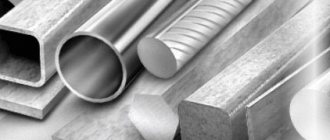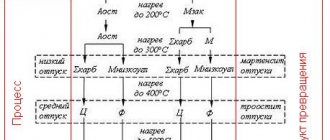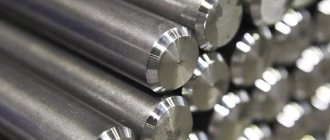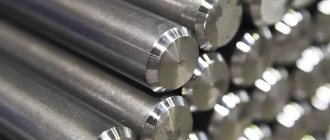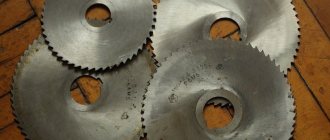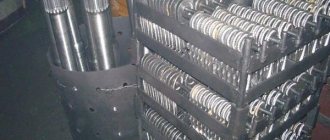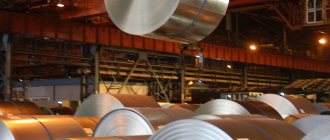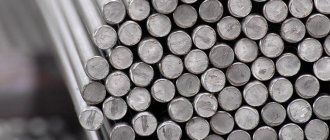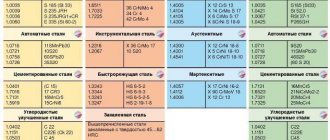The mechanical properties of steel made with alloying additives meet the stringent requirements for industrial use. To obtain steel with certain properties, silicon, manganese, chromium, titanium, molybdenum, tungsten, nickel and other chemical elements are introduced during the smelting process. One of the special steel grades produced is 60C2A, which has high strength and pronounced springing properties. The main feature of this steel is its increased yield strength. This feature makes it possible to produce various products with spring properties.
Chemical composition
The steel composition includes:
The rest of the chemical composition of 60S2A steel is represented by iron. Steel is an alloy of Fe and C with the latter content being less than 2.06%. As the percentage of carbon in the composition increases, the material becomes more sensitive to heat treatment, hardenable, durable and hard. Negative consequences include decreased ductility, toughness, and increased brittleness.
To improve the properties of the metal, alloying additives are introduced. The result is an alloy that is hard and tough, strong and resistant to corrosion.
Silicon Si is used as a deoxidizer, replacing oxygen molecules in 60C2A steel. This makes the steel stronger and more resilient. Manganese Mn is introduced for the same purpose; it prevents the formation of iron sulfides. As a result, the number of cracks during hardening of products is reduced. When the manganese content is more than 1%, grain growth occurs, which leads to a decrease in the uniformity of structure and strength.
Chromium Cr is used as an alloying component due to its ability to displace oxygen. It forms iron carbides, prevents corrosion of the alloy, and improves hardenability. Nickel Ni also increases the anti-corrosion properties of spring steel 60C2A and reduces red brittleness. Copper Cu has similar properties. When its content in the composition increases to more than 1%, intermetallic compounds are released, which reduce the processability of the metal during tempering.
A carefully calibrated composition ensures such properties of steel as strength, elasticity, impact strength, and anti-corrosion qualities.
Physical and mechanical properties of steel 60S2A
Alloy grade 60C2A has high hardness , which is calculated as follows: HB 10-1 = 269 MPa. If you take a closer and more careful look at the composition of such a brand, then in addition to carbon, you can identify other chemical elements in its composition that affect what properties it will have.
Of course, the highest proportion in the composition is carbon. But, besides it, the composition of the 60C2a alloy may include the following elements:
- from 1, 6 and to 2 percent silicon;
- from 0.60 to 0.90 percent manganese;
- from 0 to 0.30 percent chromium;
- from 0 to 0.25 percent nickel;
- from 0 to 0.20 percent copper;
- from 0 to 0.025 percent phosphorus;
- from 0 to 0.025 sulfur.
Typically, an alloy such as grade 60C2A is produced in the form of long shaped rolled products. These can be calibrated rods, strips, tapes, forged blanks and forgings, as well as ground rods in the form of finished wire. Currently, the production of alloys has stepped forward so far and progressively that you can already find 60C2A grade sheets on sale - even hot-rolled sheets.
Material properties
Based on the type of temperature treatment, the strength parameters and hardness of the product are determined. The characteristics of spring steel 60C2A in castings, circles and strips are different. In this case, the qualities of the alloy are considered using the last two examples.
The wheels are characterized by a strength of 129 MPa and a yield strength of 117 MPa. This ensures their elasticity. For comparison: the tensile strength of ST3 is 370 MPa. Tensile endurance is 490 MPa, torsional endurance is 295 MPa.
Hardening is most often used as a heat treatment method. It is carried out by cooling in oil, after which tempering is carried out to eliminate residual stresses.
Specifications
The main characteristics of 60S2A steel include:
Fragility
| lack of fragility after tempering; | |
| Flock sensitivity | lack of flake sensitivity; |
| Short-term strength limit | 780-1180 MPa; |
| Density | 7590 kg/m 3 |
| Proportionality limit | 1375 MPa; |
| elongation at break | 8%; |
| Weldability | impossibility of creating a welded joint. |
The price of 60S2A steel varies around 50 rubles. per kilogram. It varies based on the quantity of steel, timing and delivery method.
Application
The performance characteristics of steel grade 60S2A determined its scope of application. It can be used for the manufacture of loaded parts that are subject to alternating loads. These include:
- torsion bars - flexible rods that absorb torsional loads;
- collets;
- Grover washers;
- clutches;
- springs.
These elements are installed on machines, mechanisms and equipment, incl. for tracked and wheeled heavy equipment.
Heat treatment
Hardening is carried out at 870 degrees, the product cools in an oil bath. Tempering is carried out at 470 degrees, which makes it possible to obtain troostite (ferrite-cementite structure). It maintains a hardness of 35-45 HRC.
Temperature treatment is:
- initial – annealing;
- final – hardening;
- middle - vacation.
Tempering increases the hardness of 60S2A steel to 365-445 HB. If the coiling of the spring is carried out with a single heating, then the next stage is heat treatment.
Treatment
High-quality metal 60C2A can undergo various types of processing, including heat treatment. Let us consider the main features and nuances of such operations.
- The material in question must be hardened at a temperature of 870 degrees Celsius. Next, the steel billet is sent for cooling in a special oil. In this case, tempering must be carried out at 470 degrees Celsius, due to which it becomes possible to obtain troostite. The material will maintain a hardness of 35-45 HRC.
- In general, the temperature treatment of steel of the grade in question is as follows: initial (meaning annealing of the material), final (meaning hardening) and medium (meaning tempering of the steel).
- The tempering procedure contributes to a significant increase in the hardness parameters of the metal.
If the coiling of a spring part is carried out under the condition of only heating, then the next stage should be direct heat treatment in accordance with all norms and rules.
Source
Hardening
Hardening is carried out in a shot blasting machine, in which each point is exposed to shot for 20-30 seconds. Feeding is carried out at a speed of 70-100 kg/minute, the diameter of the elements is 0.8-1.2 mm. This treatment creates an even silver color.
The second treatment option is captivity. The spring is kept in a compressed state for 20-40 hours. The procedure is carried out after heat treatment of steel 60C2A. Repeated compression (5-10 times) and shot peening are also used.
Release Types
There are several main types of metal production marked 60С2А. Let's take a look at the list of the most common and popular options:
- rolled section type (this also includes shaped type);
- calibrated rods;
- steel tape;
- wire products;
- polished rods and silver;
- circle;
- sheet.
Each of the specified types of rolled products in which steel products are produced corresponds to and is regulated by a number of GOSTs.
Analogs of steel 60S2A
The following can be used as analogues of the material:
- Japanese SUP6, SUP7;
- German 60MnSiCr4, 60SiCr7, 65Si7;
- Chinese 0Si2Mn;
- French 61SiCr7;
- American steels 9260, G92600.
quote: Originally posted by TENCH:
As I understand it, its properties are closer to ShKh15 than to 65G?
| TENCH | posted 24-6-2012 17:24 |
quote: Originally posted by GAU-8A:
Why did it happen? 60С2А spring-spring class, Lord, is it really so difficult to google?!
Those. closer to 65G? Is there any point in making “metal”?
| GAU-8A | posted 24-6-2012 18:03 Yes. |
| TENCH | posted 25-6-2012 21:23 Thank you. |
| SENSXUP | posted 25-6-2012 22:12 There is a knife made of this steel, now it’s my favorite. He's hungry, yes. But it cuts very well. |
| TOPIC Minsk | posted 26-6-2012 18:52 Yep. |
| grafolog | posted 30-6-2012 13:38
What do you recommend? The fish is getting darker “before our eyes”. I will look for a more resistant material. |
| TENCH | posted 3-7-2012 21:53 Will chrome plating help? There has been no rye on my chrome-plated quick cutter for ten years. cutting edge only. |
| HarryA | posted 4-7-2012 00:17
|
knives made of steel 65G
Structural spring steel 65G, produced in accordance with GOST 14959 and is characterized by high elasticity and wear resistance. It is not for nothing that this steel is used for the manufacture of springs, bearing housings and springs, etc. for knives. Of course, this is not the best option for kitchen, hunting, tourist and similar knives, but there are two groups of bladed weapons for which 65 G is the best option. Did you guess it? Of course, these are throwing knives and tournament swords.
The photo shows a throwing knife “Twist” with an all-metal blade made of 65G steel
Decoding steel
Characteristics of steel (briefly)
- Wear resistance
- Viscosity
- Strength
- Elasticity
- Tear resistance
- Impact resistance
- The knives show a good cut (although this is of no use for throwing knives)
- Relatively low cost
Steel for tournament weapons
All of the above is relevant not only for the manufacture of throwing knives, but also for the production of tournament weapons (swords, checkers, etc.).
In the photo: Tournament weapons for the “Heroic Fun” festival in the Oruzheynik park (Zlatoust) were made from 65G steel.
Minuses
As noted above, steel belongs to the carbon group and is susceptible to corrosion. Therefore, do not forget two important rules: keep the blades dry and clean and periodically lubricate them with castor oil. Caring for knives made from 65G steel is comparable to caring for knives made from Damascus steel.
Chemical composition
| steel grade | C | Si | Mn | Cr | Mo | V | H.R.C. |
| 65G | 0.62-0.7 | 0.17-0.37 | 0.9-1.2 | 0.25 | – | – | 45-47 |
Heat treatment modes
The temperature range for hardening steel 65G is in the range of 800-830 °C. Subsequent high tempering at 160-200 °C with further cooling in still air makes it possible to obtain a steel hardness of 45-47 HRC. This grade of steel is not afraid of overheating, however, when hardened at high temperatures, the impact strength of the steel begins to decrease.
Application
A high-quality alloy that meets the established marking 60C2A is currently used in a large number of industries. The use of this type of steel implies operation under conditions of extremely severe deformations and cyclic loads. For these reasons, spring metal is subject to special requirements regarding its level of ductility, abrasion, and wear resistance.
The mechanical features of the alloy in question are most often used in the manufacture of spring parts, as well as friction-type shafts, spring elements, rods and other products of this kind. Material grade 60S2A in accordance with GOST 14959-79 is classified as highly loaded. Wire is made from this metal. Such a product is characterized by very good deforming properties. In addition, alloy 60S2A is often used in mechanical engineering. Many components that are made from this material are intended for installation on cars, various types of machinery and equipment. We are even talking about tracked or wheeled heavy equipment.
